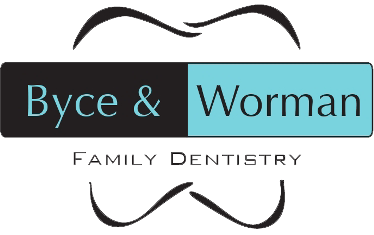Call: (608) 831-7770
Request AppointmentGeneral Dental Services
Dental Exam
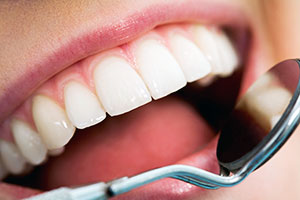
There's nothing to fear with a dental exam. Your teeth will be visually examined for signs of plaque, tartar and tooth decay. Your gums will also be examined for puffiness or discoloration, which are signs of gum disease. A full set of dental X-rays may also be taken during your dental exam, to enable your dentist to see below the surfaces of your teeth. Dental exams typically end with a dental cleaning, to remove surface stains and buildup.
Dental X-Ray
Dental X-rays have come a long way. Todays dental X-rays are safer, faster, more comfortable and more informative than the X-rays of years past. Digital X-rays, one of the latest and most advanced dental technologies, produce high-quality images of your teeth that can be viewed instantly by you and your dentist on a LCD monitor. Digital X-rays reduce radiation by up to 90% and provide exceptional diagnostic information to ensure that potential problems are caught in their earliest stages. Intraoral photography is another alternative to traditional dental X-rays. With intraoral photography, problems such as cavities, fractures and discolorations in the teeth are captured through clear and sharp photographic images that are taken with a 35mm or digital camera.
Teeth Cleaning

No matter how often you brush and floss, plaque and tartar deposits can still build up on your teeth. A professional teeth cleaning is the single most effective way to remove these deposits and prevent them from causing more serious problems in the future. While a traditional teeth cleaning involves manually scraping away these deposits, advances in dental technologies now give you more options for the three basic types of cleanings: Prophylaxis, Perio Maintenance & Full Mouth Debridement. Your oral health diagnosis will determine what type of cleaning and frequency is best for your health.
Prophy or Prophylaxis: A healthy mouth cleaning is another name for this, which removes plaque on teeth and at the gum line. This can now be done with an ultrasonic, which is a popular alternative to traditional teeth cleanings. An ultrasonic scaler (rather than a manual probe) is used to remove deposits and eliminate bacteria around the teeth and gums through high-frequency sound waves. Many patients find using the ultrasonic more comfortable than traditional teeth cleanings. Patients diagnosed with periodontal disease will not benefit from a prophy cleaning, which does not go below the gum line.
Includes:
- Removing small deposits of plaque
- Polishing
- Fluoride application
- Hygiene instructions
Frequency: Once every six months
Perio Maintenance: Ongoing cleaning therapy above and below the gum line after root planning, perio scaling, or other perio surgical treatment is completed. This is critical for maintaining oral health if you are diagnosed with periodontal disease. Perio maintenance is performed more frequently than a prophy cleaning.
Includes:
- Site specific scaling & root planning
- Antimicrobial irrigation
- Placing localized antibiotics
- Fluoride application
- Polishing
- Hygiene instructions
Frequency: Determined after periodontal cleanings are complete. Ranges from once every three months to once every six months.

Includes:
- Removing plaque buildup
- Antimicrobial irrigation
- Hygiene instructions
Frequency: Once per lifetime assuming regular dental appointments and home care is completed.
Non-Surgical Perio Therapy: Periodontal gum disease is very common in adults. Limiting treatment to what your insurance covers could be a detriment to your oral health. Once diagnosed with periodontal disease, you will no longer benefit from a prophy cleaning which does not clean above and below the gum line. A deep cleaning may be recommended if excessive plaque and tartar deposits have developed below the gum line. Deep cleanings, also known as scaling and root planing, involve a two-part process: first, the stubborn deposits are removed, and then the root surfaces are smoothened. A deep cleaning helps treat periodontal disease and restores gum tissues to a healthy state. This is typically scheduled in two office visits followed by routine perio maintenance cleanings.
Scaling & Root Planing (SRP)
Includes:
- Removal of calculus and plaque above & below the gum line
- Localized antibiotics
- Smoothing root surfaces
- Antimicrobial irrigation
- Desensitizer Application
- Fluoride Application
- Hygiene instructions
Oral Cancer Screening
Oral cancer affects nearly 35,000 Americans every year. The keys to surviving oral cancer are early detection and early treatment. This starts with a regular oral cancer screening – at least once every six months. An oral cancer screening takes just minutes, is pain-free and can be performed during regular dental exams. If you are male, a regular oral cancer screening is especially critical: Oral cancer is more than twice as common in men as it is in women. Other people at high risk of oral cancer include people over the age of 60, tobacco smokers and heavy drinkers.
Pediatric Dentistry
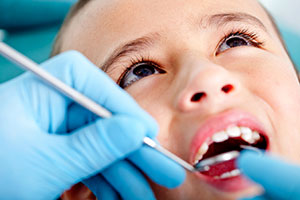
Waterlase Pain Free Dentistry
If just the thought of needles and the dreaded sound of the dental drill makes you cringe, the WaterLase can help alleviate your fears. Using water, air and advanced laser technology, the WaterLase allows your dentist to use little and in some case even no anesthetic or drills to perform many dental procedures. Precise, safe and effective, the WaterLase can also help reduce any bleeding or swelling associated with traditional dental tools and methods.
Dental Fillings
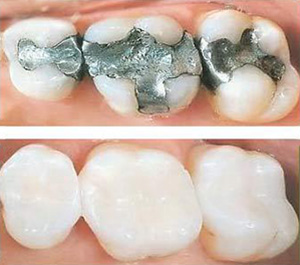
White Fillings
If your silver fillings make you feel self conscious when you smile, or it's simply time to replace them, consider white fillings. White fillings are just as durable as they are attractive! Made of composite resin, white fillings match the natural color of your teeth and are an excellent option for small to mid-sized cavities. White fillings are strong, stain-resistant and require less removal of your tooth structure than amalgam fillings.
Dental Crowns
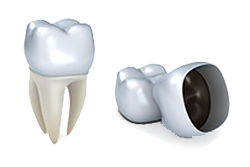
Root Canal Treatment
Root canals get a bad wrap. But don't believe the rumors; the dreaded root canal isn't dreadful at all! Root canals are needed when either decay or an injury infects the inner tooth (the pulp). In the earliest stages of infection, you may not feel any pain at all. But when it progresses, you could have a toothache and swelling, or a dental abscess might form. Root canals remove the infection and prevent it from spreading. Thanks to laser root canals, this process is faster, more comfortable and, in many cases, more thorough than conventional root canals. Pulp capping is an alternative to root canals that are used when the infection has yet to penetrate the pulp. Pulp capping can also prevent a large dental filling from getting too close to the nerve.
Dental Bridges
Dental bridges have been used for centuries to replace missing teeth. Today, dental bridges are still considered one of the most durable, conservative and cost-effective options for bridging the gap between a missing tooth and surrounding teeth. Comprised of two anchoring teeth and a replacement tooth, dental bridges help prevent surrounding teeth from drifting out of position, improve chewing and speaking, and help keep your natural face shape in tact.
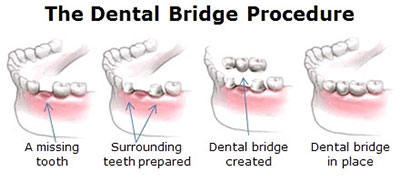
There are three types of dental bridges: 1) traditional dental bridges, 2) cantilever dental bridges, and 3) Maryland bridges. Traditional bridges have either dental crowns or dental implants on either side of the missing tooth, plus a replacement tooth, which is held in place by a post-like structure called a dental abutment. Cantilever dental bridges are used in cases where there are surrounding teeth only on one side of the missing tooth. Maryland bridges are made of a specialized resin that is cemented to a metal framework and cemented to the enamel of surrounding teeth.
Dental bridges typically take 2-3 weeks to complete and are less invasive than other options, such as dental implants. With good oral hygiene and regular dental visits, dental bridges can last up to 30 years.
Dental Implants
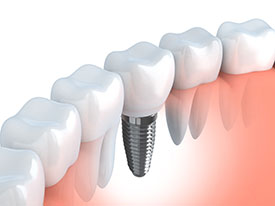 A dental implant is a state of the art surgical component that fills the spaces in your mouth, where teeth are missing, by interfacing with the jaw bone to support a dental restoration such as a crown. The crown restoration placed on the dental implant will feel and look like your natural tooth. An implant serves as a substitute for a tooth root, allowing for a strong and sturdy foundation for a replacement tooth.
A dental implant is a state of the art surgical component that fills the spaces in your mouth, where teeth are missing, by interfacing with the jaw bone to support a dental restoration such as a crown. The crown restoration placed on the dental implant will feel and look like your natural tooth. An implant serves as a substitute for a tooth root, allowing for a strong and sturdy foundation for a replacement tooth.
Dentures
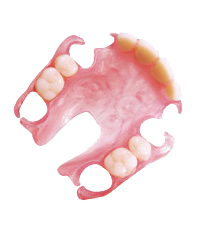
The process of getting dentures may take a few months and several dental visits. In some cases, however, same-day dentures are also possible. With same-day dentures, the dentures are created right in the dentist's office instead of at an offsite laboratory. Same-day dentures aren't for everyone, though. If your dentures require a lot of customization, same-day dentures may not be right for you.
Just as with your natural teeth, dentures require daily maintenance. With regular wear and tear, your dentures can last 5-7 years. During that time, you may need periodic denture relines to accommodate changes in the contours of your mouth. Regular denture relines involve resurfacing the base to ensure that your dentures fit and function perfectly. If you break your dentures, it's critical to bring them to your dentist for professional denture repair. Home denture repair kits can cause more damage and be even more costly to fix.
A denture is a removable replacement for missing teeth and surrounding tissues. Dentures are made to resemble your natural teeth so there should be minimal change to your appearance. In fact, dentures may even improve your smile!
Extractions
Good oral hygiene should always be practiced, since the loss of a single tooth can have major impact upon your oral health and appearance. Dr. Byce and Dr. Worman will use every measure to prevent tooth loss; however there are still occasions in which a tooth may need to be extracted.
TMJ Treatment
TMJ stands for temporal-mandibular joint. People suffering from problems with this joint can experience headaches, earaches, trouble opening the mouth, clicking or popping of the jaw and pain in the jaw muscles. Dr. Byce is specially certified in treating TMJ.
